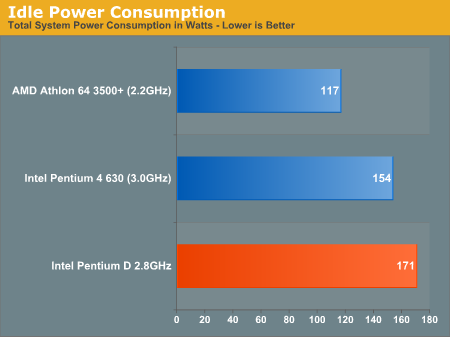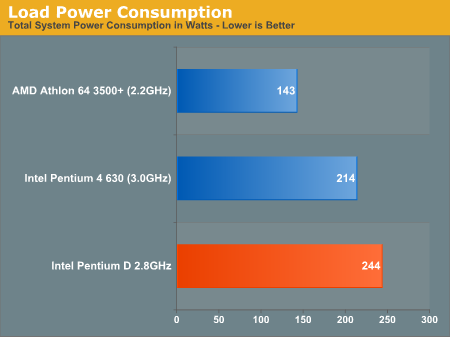Intel Dual Core Performance Preview Part II: A Deeper Look
by Anand Lal Shimpi on April 6, 2005 12:23 PM EST- Posted in
- CPUs
I'll admit, dual core has me excited for many of the reasons outlined in Part I. A big part is that personally, I've been using multiprocessor systems in my main computer for years. I've always appreciated the benefits of multiprocessor platforms, but recommending one for a desktop user has never been really feasible. Even the cheapest 2P workstation motherboards were at least twice the price of a desktop motherboard, not to mention the cost of the CPUs. The mass market had a short affair with multiprocessing in the days of the ABIT BP6 and the Celeron 300A, but in the grand scheme of things, that was barely a blip on the radar. Now, for the first time, both AMD and Intel are ready to bring the type of robustness of multiprocessor platforms to the desktop with their dual core offerings.
Part I focused on what dual core can offer, but now it's time for a much more practical look. We've never recommended Intel's Extreme Edition line of processors nor AMD's FX series, both supposedly marketed to gamers, but not purchased by any of our gaming readers. The processors that we recommend are usually much better values for the price, and thus, today's comparison isn't based around the most expensive dual core offerings, but rather the cheapest.
A point we made in the first article was that Intel's pricing strategy for dual core is extremely aggressive, with the cheapest 2.8GHz Pentium D soon to be introduced at $241. The problem is that at only 2.8GHz, the Pentium D won't have the strongest single threaded performance, which puts buyers in a sticky situation - do you buy an Athlon 64 3500+ for great single threaded performance or will the Pentium D give you a better overall multitasking experience? Intel doesn't do much to complicate the situation, as the Pentium D 2.8GHz will be close in price to the Pentium 4 630 (3.0GHz), which isn't much of a clock speed advantage. AMD will eventually have competitively priced dual core parts, but right now, AMD doesn't appear to be looking at the mainstream desktop market for dual core Athlon 64 chips.
The three chips mentioned above are the basis of the majority of today's comparison, but the decision is far from clear cut. Let's find out why.
Power Consumption
We'll start with power consumption - the contenders? A 90nm Athlon 64 3500+ vs. the Pentium 4 630 and the dual core 2.8GHz Pentium D. As always, we measured total system power at two states: idle and under a full load. For our full load test, we used a multithreaded application, 3ds max 7, performing the CBALLS2 render test from the SPECapc benchmark.


The K8 architecture simply lends itself to lower power consumptions than Intel's high frequency approach to computing with the Pentium 4 (especially Prescott). The move down to 90nm really reduced AMD's power consumption a lot, to the point where the 90nm Athlon 64 3500+ actually consumes less power under full load than the Pentium 4 630 at idle.
The Pentium 4 vs. Pentium D comparison is also interesting, as the 2nd core doesn't add all that much to overall system power consumption. In this case, we're looking at an increase in overall system power consumption by less than 15%. Intel still doesn't win in the power consumption department though; if you want something cool and quiet, AMD is still the way to go.
The Test
Our hardware configurations are similar to what we've used in previous comparisons.
AMD Athlon 64 Configuration
Socket-939 Athlon 64 CPUs
2 x 512MB OCZ PC3200 EL Dual Channel DIMMs 2-2-2-10
NVIDIA nForce4 Reference Motherboard
ATI Radeon X850 XT PCI Express
Intel Pentium 4 Configuration
LGA-775 Intel Pentium 4 and Extreme Edition CPUs
2 x 512MB Crucial DDR-II 533 Dual Channel DIMMs 3-2-2-12
Intel 955X Motherboard
ATI Radeon X850 XT PCI Express










106 Comments
View All Comments
Umbra55 - Thursday, April 7, 2005 - link
Why do you still use the nForce 4 reference board for AMD tests? The real nForce 4 boards exist since over a quarter now and perform 10% better than the reference board. You also pretend to compare CPUs with similar price. Wouldn't it make more sense to compare combinations of mobo/CPU/memory of similar price?This is not a fair comparison (Or is it the intention?)
Umbra55 - Thursday, April 7, 2005 - link
yde - Thursday, April 7, 2005 - link
In this atricle, I was unable to find cache information about the AMD chip (usually equipped with a 512 KB L2 cache).To my point of view, in multiple threads scenario, the cache size may have dramatic influence and may explain several handicaps in the benchmarks. It would be nice to know what happens with a 1MB L2 cache Athlon 64 to keep things equal.
AMD chip has shorter branch prediction lines and seem quite well equipped for multitasking in theory, so why is it appearing so weak?
snorre - Thursday, April 7, 2005 - link
We're still waiting for proper benchmarks comparing dual core Smithfield with dual Opteron/Xeon. When will we see this?Comparing dual core CPUs with single core CPUs is like comparing apples and oranges, totally meaningless.
Calin - Thursday, April 7, 2005 - link
Thanks for the minimum frame rate comparison! And maybe you should not use so many flash-heavy pages, especially considering that you already told us that Athlon64 is much slower in Flash than Pentium4...Looks like Pentium D is a better choice in more ways than the Prescott is
xsilver - Thursday, April 7, 2005 - link
The multitasking gaming analysis combined with HT and NCQ was very insightful, almost pioneering...and with dual core AMD's people have to remember that the whole architecture is designed differently, and hence the possible suprises in tasks that the pentium D may not perform well on
but the power consumption advantage on amd is mighty tempting as amd will be the cpu that just keeps on saving -- with power bills that is
Azsen - Thursday, April 7, 2005 - link
Hi Anand,I was thinking, seeing most games are single-threaded you might like to try and benchmark this scenario on the dual core machine:
Set all the processes including operating system processes and other background processes to run on CPU 0 (first core). Then set the particular game to run on CPU 1 (second core). Have nothing else but the game running on CPU 1. This should dedicate a whole CPU core to the game for maximum performance in theory. I believe you can set the affinity in the task manager or use a batch file to do it.
Then run a Doom3 benchmark or HL2 benchmarks to see if the gaming performance is increased by letting the single-threaded game have a whole CPU core with no interuptions.
Would this be feasible to test?
Cheers. :)
AnnoyedGrunt - Wednesday, April 6, 2005 - link
The AMD not competing with the PD 2.8 will be due to price.Remember that AMD will need to sell a 2 core 2.2 GHz processor for about double the price of the single core version (maybe even more if yields are a problem). Therefore, you should expect a dual core 2.2 proc to be closer to $500-600 instead of the ~$300 processors tested here.
This also explains why AMD is focusing on the workstation market first. It's an area where price is typically not as much a factor, and where they are competing with Xeon prices, so it will be much easier for them to sell procs @ the higher prices.
I'm guessing that AMD's desktop dual core procs will start @ 1.6 or 1.8 GHz, and be priced on par with the Intel offerings. I think the overall performance will be similar to the current single core behavior, but now you can have more stuff running.
I currently have an AMD 939 3200+, so I am looking forward to their dual core offerings in a couple years, and hoping my mobo will be compatible. That would be very cool.
Also, I would like to add vote for a WoW test with Teamspeak running in the background as well as an istance if IE or Firefox with tthotbot.
Thanks,
D'oh!
SLIM - Wednesday, April 6, 2005 - link
Hi Anand,Any chance you could give us a little peak at what dual opterons on the nforce pro chipset can do in the same benches that you did in this article.
A configuration something like this:
Opteron 252s clocked at 1.8GHz, 2.2GHz, 2.6GHz
1 GB ECC DDR400
NVIDIA nForce pro motherboard
ATI Radeon X850 XT PCI Express
NCQ enabled HDD (maxline III, 7200.8, etc)
I looked through all the old articles I could find, but most seemed to contain only server oriented benches. I think that kind of article would be very enlightening as to the future performance of dual core athlons (probably within a couple percent)... maybe help put to rest some of the questions a lot of us have about waiting for amd dualcore, intel dualcore or just overclocking the heck out of a venice a64.
SLIM
Jep4444 - Wednesday, April 6, 2005 - link
SSE3 does almost nothing for the Venice which is barely faster than the Winchester(Xbit Labs benchmarked it already)While Anandtech said the dual cored A64s wouldn't compete with the Pentium D in encoding, unless they actually have dual cored A64s which they can't show us, i'd be willing to argue with that. Encoding is one of those things thats largely affected by Hyper-Threading and the Pentium D loses hyper threading. When the A64 goes dual, its performance increase will be larger than Intels.